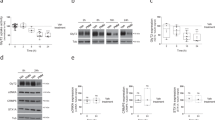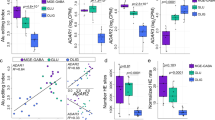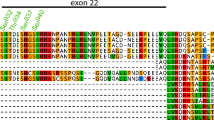Abstract
The function of supramedullary glycine receptors (GlyRs) is still unclear. Using Wistar rat collicular slices, we demonstrate GlyR-mediated inhibition of spike discharge elicited by low glycine (10 μM). Searching for the molecular basis of this phenomenon, we identified a new GlyR isoform. GlyRα3P185L, a result of cytidine 554 deamination, confers high glycine sensitivity (EC50 ∼5 μM) to neurons and thereby promotes the generation of sustained chloride conductances associated with tonic inhibition. The level of GlyRα3-C554U RNA editing is sensitive to experimentally induced brain lesion, inhibition of cytidine deamination by zebularine and inhibition of mRNA transcription by actinomycin D, but not to blockade of protein synthesis by cycloheximide. Conditional regulation of GlyRα3P185L is thus likely to be part of a post-transcriptional adaptive mechanism in neurons with enhanced excitability.
This is a preview of subscription content, access via your institution
Access options
Subscribe to this journal
Receive 12 print issues and online access
$209.00 per year
only $17.42 per issue
Buy this article
- Purchase on Springer Link
- Instant access to full article PDF
Prices may be subject to local taxes which are calculated during checkout





Similar content being viewed by others
References
Fritschy, J.M. & Brünig, I. Formation and plasticity of GABAergic synapses: physiological mechanisms and pathophysiological implications. Pharmacol. Ther. 98, 299–323 (2003).
Semyanov, A., Walker, M.C., Kullmann, D.M. & Silver, R.A. Tonically active GABA A receptors: modulating gain and maintaining the tone. Trends Neurosci. 27, 262–269 (2004).
Legendre, P. The glycinergic inhibitory synapse. Cell. Mol. Life Sci. 58, 760–793 (2001).
Meier, J. & Grantyn, R. A gephyrin-related mechanism restraining glycine receptor anchoring at GABAergic synapses. J. Neurosci. 24, 1398–1405 (2004).
Breustedt, J., Schmitz, D., Heinemann, U. & Schmieden, V. Characterization of the inhibitory glycine receptor on entorhinal cortex neurons. Eur. J. Neurosci. 19, 1987–1991 (2004).
Mori, M., Gähwiler, B.H. & Gerber, U. Beta-Alanine and taurine as endogenous agonists at glycine receptors in rat hippocampus in vitro. J. Physiol. (Lond.) 539, 191–200 (2002).
Flint, A.C., Liu, X. & Kriegstein, A.R. Nonsynaptic glycine receptor activation during early neocortical development. Neuron 20, 43–53 (1998).
Chattipakorn, S.C. & McMahon, L.L. Pharmacological characterization of glycine-gated chloride currents recorded in rat hippocampal slices. J. Neurophysiol. 87, 1515–1525 (2002).
Chattipakorn, S.C. & McMahon, L.L. Strychnine-sensitive glycine receptors depress hyperexcitability in rat dentate gyrus. J. Neurophysiol. 89, 1339–1342 (2003).
McGale, E.H., Pye, I.F., Stonier, C., Hutchinson, E.C. & Aber, G.M. Studies of the inter-relationship between cerebrospinal fluid and plasma amino acid concentrations in normal individuals. J. Neurochem. 29, 291–297 (1977).
Whitehead, K.J., Manning, J.P., Smith, C.G. & Bowery, N.G. Determination of the extracellular concentration of glycine in the rat spinal cord dorsal horn by quantitative microdialysis. Brain Res. 910, 192–194 (2001).
Roux, M.J. & Supplisson, S. Neuronal and glial glycine transporters have different stoichiometries. Neuron 25, 373–383 (2000).
Kennedy, R.T., Thompson, J.E. & Vickroy, T.W. In vivo monitoring of amino acids by direct sampling of brain extracellular fluid at ultralow flow rates and capillary electrophoresis. J. Neurosci. Methods 114, 39–49 (2002).
Higuchi, M. et al. RNA editing of AMPA receptor subunit GluR-B: a base-paired intron-exon structure determines position and efficiency. Cell 75, 1361–1370 (1993).
Gurevich, I. et al. Altered editing of serotonin 2C receptor pre-mRNA in the prefrontal cortex of depressed suicide victims. Neuron 34, 349–356 (2002).
Bhalla, T., Rosenthal, J.J., Holmgren, M. & Reenan, R. Control of human potassium channel inactivation by editing of a small mRNA hairpin. Nat. Struct. Mol. Biol. 11, 950–956 (2004).
Kohler, M., Burnashev, N., Sakmann, B. & Seeburg, P.H. Determinants of Ca2+ permeability in both TM1 and TM2 of high affinity kainate receptor channels: diversity by RNA editing. Neuron 10, 491–500 (1993).
Powell, L.M. et al. A novel form of tissue-specific RNA processing produces apolipoprotein-B48 in intestine. Cell 50, 831–840 (1987).
Skuse, G.R., Cappione, A.J., Sowden, M., Metheny, L.J. & Smith, H.C. The neurofibromatosis type I messenger RNA undergoes base-modification RNA editing. Nucleic Acids Res. 24, 478–485 (1996).
Breitinger, H.G. & Becker, C.M. The inhibitory glycine receptor-simple views of a complicated channel. ChemBioChem 3, 1042–1052 (2002).
Kuhse, J., Schmieden, V. & Betz, H. Identification and functional expression of a novel ligand binding subunit of the inhibitory glycine receptor. J. Biol. Chem. 265, 22317–22320 (1990).
Haliassos, A. et al. Detection of minority point mutations by modified PCR technique: a new approach for a sensitive diagnosis of tumor-progression markers. Nucleic Acids Res. 17, 8093–8099 (1989).
Ireton, G.C., McDermott, G., Black, M.E. & Stoddard, B.L. The structure of Escherichia coli cytosine deaminase. J. Mol. Biol. 315, 687–697 (2002).
Vincenzetti, S. et al. Possible role of two phenylalanine residues in the active site of human cytidine deaminase. Protein Eng. 13, 791–799 (2000).
Stell, B.M. & Mody, I. Receptors with different affinities mediate phasic and tonic GABAA conductances in hippocampal neurons. J. Neurosci. 22, RC223 (2002).
Zhou, L. et al. Zebularine: a novel DNA methylation inhibitor that forms a covalent complex with DNA methyltransferases. J. Mol. Biol. 321, 591–599 (2002).
Cheng, J.C. et al. Inhibition of DNA methylation and reactivation of silenced genes by zebularine. J. Natl. Cancer Inst. 95, 399–409 (2003).
Yoo, C.B., Cheng, J.C. & Jones, P.A. Zebularine: a new drug for epigenetic therapy. Biochem. Soc. Trans. 32, 910–912 (2004).
Seeburg, P.H. & Hartner, J. Regulation of ion channel/neurotransmitter receptor function by RNA editing. Curr. Opin. Neurobiol. 13, 279–283 (2003).
Backus, J.W. & Smith, H.C. Three distinct RNA sequence elements are required for efficient apolipoprotein B (apoB) RNA editing in vitro. Nucleic Acids Res. 20, 6007–6014 (1992).
Wedekind, J.E., Dance, G.S., Sowden, M.P. & Smith, H.C. Messenger RNA editing in mammals: new members of the APOBEC family seeking roles in the family business. Trends Genet. 19, 207–216 (2003).
Meier, J., Jüttner, R., Kirischuk, S. & Grantyn, R. Synaptic anchoring of glycine receptors in developing collicular neurons under control of metabotropic glutamate receptor activity. Mol. Cell. Neurosci. 21, 324–340 (2002).
De Saint, J., David-Watine, B., Korn, H. & Bregestovski, P. Activation of human α1 and α2 homomeric glycine receptors by taurine and GABA. J. Physiol. (Lond.) 535, 741–755 (2001).
Mangin, J.M. et al. Kinetics properties of the α2 homo-oligomeric glycine receptor impairs a proper synaptic functioning. J. Physiol. (Lond.) 553, 369–386 (2003).
Harvey, R.J. et al. GlyR α3: an essential target for spinal PGE2-mediated inflammatory pain sensitization. Science 304, 884–887 (2004).
Haverkamp, S. et al. Diversity of glycine receptors in the mouse retina: Localization of the α3 subunit. J. Comp. Neurol. 465, 524–539 (2003).
Grantyn, A., Moschovakis, A.K. & Kitama, T. Control of orienting movements: role of multiple tectal projections to the lower brainstem. Prog. Brain Res. 143, 423–438 (2004).
Hikosaka, O. & Wurtz, R.H. Effects on eye movements of a GABA agonist and antagonist injected into monkey superior colliculus. Brain Res. 272, 368–372 (1983).
Meyer, G., Kirsch, J., Betz, H. & Langosch, D. Identification of a gephyrin binding motif on the glycine receptor β subunit. Neuron 15, 563–572 (1995).
Danglot, L., Rostaing, P., Triller, A. & Bessis, A. Morphologically identified glycinergic synapses in the hippocampus. Mol. Cell. Neurosci. 27, 394–403 (2004).
Jüttner, R., Meier, J. & Grantyn, R. Slow IPSC kinetics, low levels of α1 subunit expression and paired-pulse depression are distinct properties of neonatal inhibitory GABAergic synaptic connections in the mouse superior colliculus. Eur. J. Neurosci. 13, 2088–2098 (2001).
Henneberger, C. et al. GluR- and TrkB-mediated maturation of GABA receptor function during the period of eye opening. Eur. J. Neurosci. 21, 431–440 (2005).
Richerson, G.B. & Wu, Y. Dynamic equilibrium of neurotransmitter transporters: not just for reuptake anymore. J. Neurophysiol. 90, 1363–1374 (2003).
Rivera, C. et al. The K+Cl− co-transporter KCC2 renders GABA hyperpolarizing during neuronal maturation. Nature 397, 251–255 (1999).
Baker, A.J. et al. Changes in extracellular concentrations of glutamate, aspartate, glycine, dopamine, serotonin, and dopamine metabolites after transient global ischemia in the rabbit brain. J. Neurochem. 57, 1370–1379 (1991).
Meier, J., Akyeli, J., Kirischuk, S. & Grantyn, R. GABAA receptor activity and PKC control inhibitory synaptogenesis in CNS tissue slices. Mol. Cell. Neurosci. 23, 600–613 (2003).
Henneberger, C., Grantyn, R. & Rothe, T. Rapid genotyping of newborn gene mutant mice. J. Neurosci. Methods 100, 123–126 (2000).
Brewer, G.J. & Cotman, C.W. Survival and growth of hippocampal neurons in defined medium at low density: advantages of a sandwich culture technique or low oxygen. Brain Res. 494, 65–74 (1989).
Meier, J. & Schmieden, V. Inhibition of α-subunit glycine receptors by quinoxalines. Neuroreport 14, 1507–1510 (2003).
Vannier, C. & Triller, A. Biology of the postsynaptic glycine receptor. Int. Rev. Cytol. 176, 201–244 (1997).
Acknowledgements
We thank U. Neumann for excellent technical assistance and S. Kirischuk for comments on earlier versions of the manuscript. This work was supported by the Deutsche Forschungsgemeinschaft (grant SFB 515 B2 to R.G.), by Charité University Medicine funding, and by the Medical Research Council (R.J.H.).
Author information
Authors and Affiliations
Corresponding author
Ethics declarations
Competing interests
The authors declare no competing financial interests.
Supplementary information
Supplementary Figure 1
Distribution of GlyRα3 in the adult brain. (PDF 570 kb)
Rights and permissions
About this article
Cite this article
Meier, J., Henneberger, C., Melnick, I. et al. RNA editing produces glycine receptor α3P185L, resulting in high agonist potency. Nat Neurosci 8, 736–744 (2005). https://doi.org/10.1038/nn1467
Received:
Accepted:
Published:
Issue Date:
DOI: https://doi.org/10.1038/nn1467
This article is cited by
-
Splicing and editing of ionotropic glutamate receptors: a comprehensive analysis based on human RNA-Seq data
Cellular and Molecular Life Sciences (2021)
-
Chloride transporter KCC2-dependent neuroprotection depends on the N-terminal protein domain
Cell Death & Disease (2015)
-
Membrane distribution of the glycine receptor α3 studied by optical super-resolution microscopy
Histochemistry and Cell Biology (2014)
-
Kinetic Analysis of Miniature Synaptic Currents in Rat Substantia Gelatinosa Neurons
Neurophysiology (2012)
-
When you can’t trust the DNA: RNA editing changes transcript sequences
Cellular and Molecular Life Sciences (2011)



